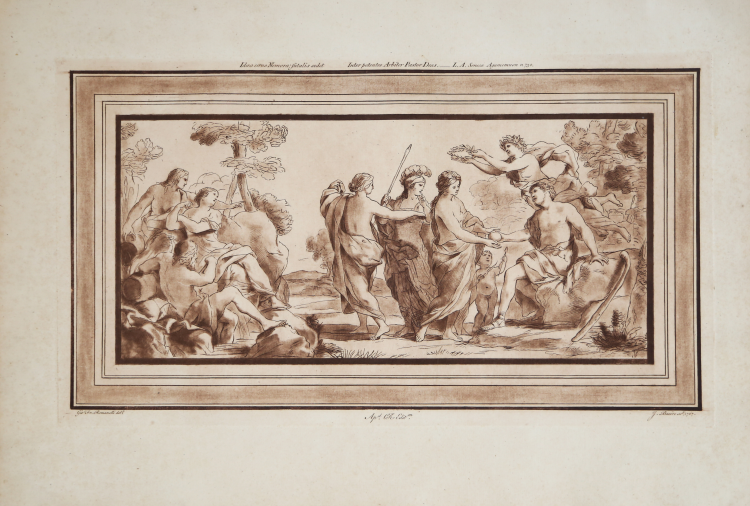



| Reference: | S49841 |
| Author | James BASIRE |
| Year: | 1767 |
| Measures: | 460 x 260 mm |


| Reference: | S49841 |
| Author | James BASIRE |
| Year: | 1767 |
| Measures: | 460 x 260 mm |
The judgement of Paris: Paris standing on the right with an angel holding a laurel crown above her hair, picking up a fruit that a young man hands her; a young boy between them holding a bow and arrow; a soldier behind Paris holding a lance, and three other figures resting on the left; in rectangular frame in imitation of a wash mount; after Giovanni Francesco Romanelli.
Etching and mezzotint, 1767, lettered below the image with production details.
From Tome I of Charles Rogers “A Collection of Prints in Imitation of Drawings to which are annexed lives with explanatory and critical notes by Charles Rogers Esq. F.R.S. S.A.L. / Quantanus nobis denegatur diu viver relinquamus aliquid quo nos vixisse testemur. Plin. Lib. III. Epist. 7 / Stampato da J. Nicholls, successore di Mr Bowyer e venduto da John Boydell, incisore, n. 93, Cheapside. Benjamin White, presso Horace's Head, Fleet-Street. Peter Molini, in Oxendon-Street, Hay-Market M.DCC.LXXVIII”.
The plates were engraved after drawings in major British collections, including Charles Rogers' own, and published in two volumes in London.
A very good impression on contemporary laid paper, with margins, a light foxing, otherwise in good condition.
James BASIRE (1730–1802, Londra)
|
James Basire FSA (1730–1802 London), also known as James Basire Sr., was a British engraver. He is the most significant of a family of engravers and noted for his apprenticing of the young William Blake. His father was Isaac Basire (1704–1768), a cartographer, his son (1769–1822) and grandson (1796–1869) were also named James; these four generations of Basires were all engravers. Their longevity produced overlapping careers, which has led to difficulties in attribution of some works. A member of the Society of Antiquaries, James Basire specialized in prints depicting architecture. His studio was on Great Queen Street in London. His appointment as engraver to society, as were all three generations, and much of his finest work is found in Vetusta Monumenta. A major piece was his copperplate for Field of the Cloth of Gold, an exquisitely detailed translation of a watercolour by Edward Edwards; this oversize historical print was issued on 'Antiquarian' paper. Excellent work also appeared in Richard Gough's Sepulchral Monuments. On 4 August 1772, William Blake was apprenticed to Basire for the term of seven years. There is no record of any serious disagreement or conflict between the two during the period of Blake's apprenticeship. However, Peter Ackroyd's biography notes that Blake was later to add Basire's name to a list of artistic adversaries – and then crossed it out. He assisted in the production of Stuart's Athens and engraved several good portraits of eminent men. He died in London.
|
James BASIRE (1730–1802, Londra)
|
James Basire FSA (1730–1802 London), also known as James Basire Sr., was a British engraver. He is the most significant of a family of engravers and noted for his apprenticing of the young William Blake. His father was Isaac Basire (1704–1768), a cartographer, his son (1769–1822) and grandson (1796–1869) were also named James; these four generations of Basires were all engravers. Their longevity produced overlapping careers, which has led to difficulties in attribution of some works. A member of the Society of Antiquaries, James Basire specialized in prints depicting architecture. His studio was on Great Queen Street in London. His appointment as engraver to society, as were all three generations, and much of his finest work is found in Vetusta Monumenta. A major piece was his copperplate for Field of the Cloth of Gold, an exquisitely detailed translation of a watercolour by Edward Edwards; this oversize historical print was issued on 'Antiquarian' paper. Excellent work also appeared in Richard Gough's Sepulchral Monuments. On 4 August 1772, William Blake was apprenticed to Basire for the term of seven years. There is no record of any serious disagreement or conflict between the two during the period of Blake's apprenticeship. However, Peter Ackroyd's biography notes that Blake was later to add Basire's name to a list of artistic adversaries – and then crossed it out. He assisted in the production of Stuart's Athens and engraved several good portraits of eminent men. He died in London.
|